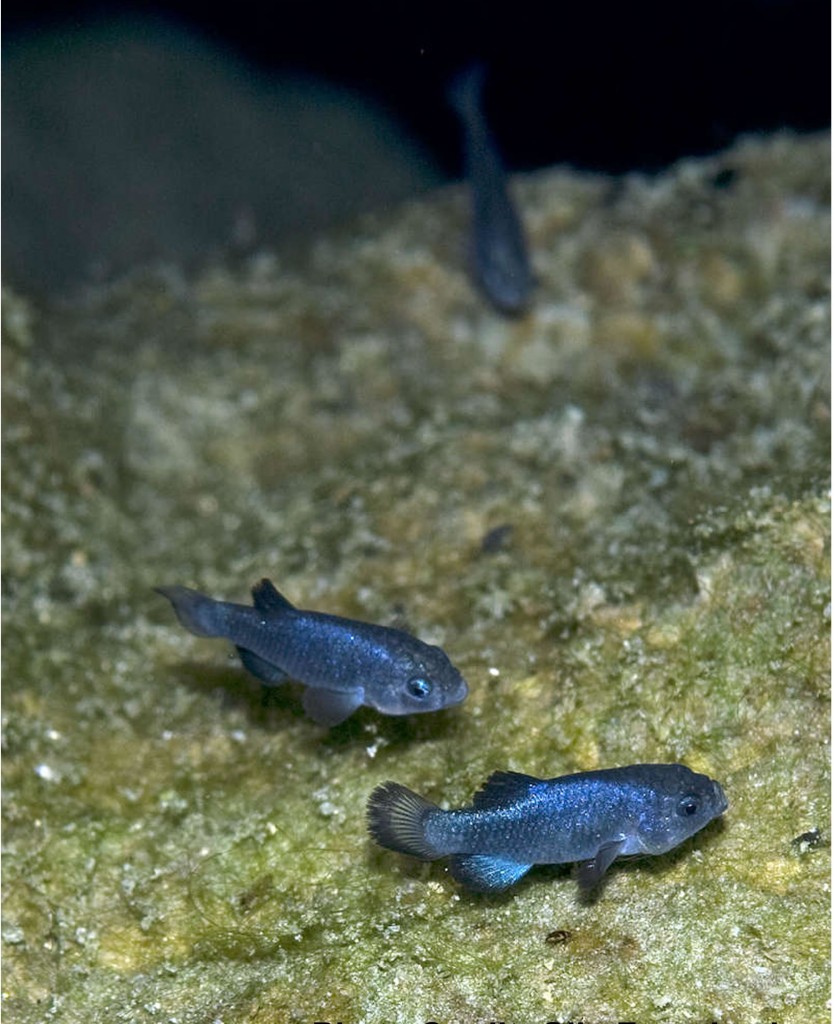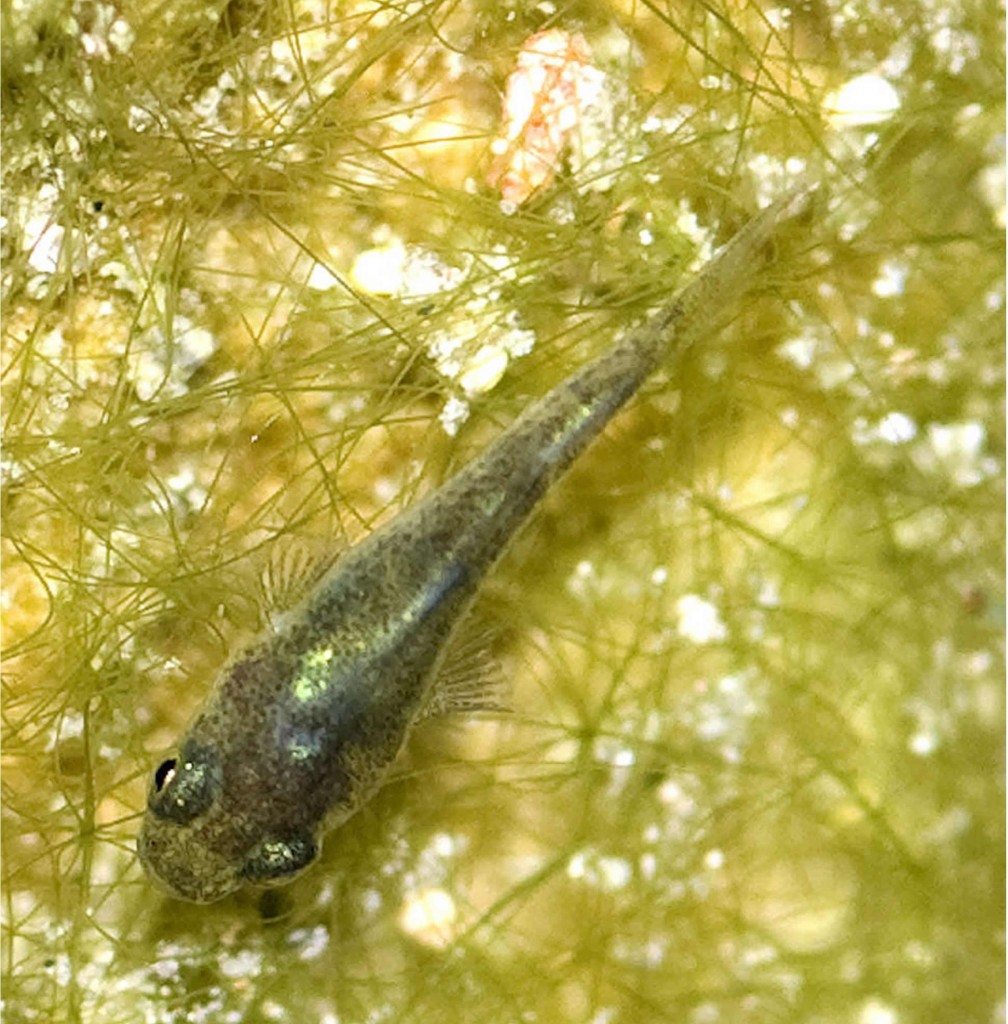26 August 2014
Heating up the fishbowl: Climate change threatens endangered Devils Hole pupfish
Posted by abranscombe
By Alexandra Branscombe
WASHINGTON, DC – Climate change is hurting reproduction of the critically endangered Devils Hole pupfish, threatening the survival of the already small population, new research shows.
Scientists report in a new study that water in the isolated cavern in the Nevada desert where the pupfish live is heating up as a result of climate change. The hotter water over the past 30 years has shortened the amount of time pupfish eggs have to hatch and larvae to develop by one week, leading to fewer young pupfish being born and contributing to threats to the survival of the adult pupfish population, according to a new study published earlier this month in Water Resources Research, a journal of the American Geophysical Union.

The critically endangered Devils Hole pupfish faces possible extinction from climate change, according to a new study in the journal Water Resources Research. Climate warming is increasing the peak water temperatures in the pupfish’s spawning zone, reducing survival odds of the young born each year.
Credit: Olin Feuerbacher
Recent surveys have counted 92 Devils Hole pupfish living in the 130-meter (426-foot) deep limestone cavern in Death Valley National Park, down from more than 500 fish in the early 1990s, according to the U.S. National Park Service.
“Climate change is making it harder for the Devils Hole pupfish to survive and is contributing to the decline that we are seeing,” said Mark Hausner, a hydrologist at the Desert Research Institute in Las Vegas, Nevada, and lead author of the new study.
Devils Hole will also likely become less hospitable to the pupfish as climate change continues to warm the planet, he said. The new research found that increasing temperatures will likely cause the pupfish’s spring recruitment period — the 10-week period during which water temperatures are right for egg hatching and when enough food is available to sustain the newly hatched pupfish larvae — to be reduced by another two weeks by mid-century. Climate change could also affect the availability of windblown plants from the surrounding desert that contribute to pupfish nourishment, reducing the chances that young fish will mature into adults, said the study.
The pupfish have a 10- to 14-month lifespan, so one breeding year when no new pupfish are born could lead to extinction of the endangered species, said Hausner.
“There is no question that the temperature is going to rise, and there is no question that the fish is going to be affected,” added Scott Tyler, a professor of geological sciences at the University of Nevada, Reno, and co-author of the new study. “This is a fish that does live in a fishbowl, and you can’t move the fishbowl.”
The iridescent blue, two-and-a-half-centimeter (one-inch) long Devils Hole pupfish have lived in the top 24 meters (80 feet) of the water-filled cavern for more than 10,000 years. They were listed as endangered in 1967 after their numbers started to decline when water levels in the cavern fell as a result of groundwater pumping for agricultural development.
Reduced availability of food, inbreeding, and low water levels from earlier pumping continued to threaten the pupfish over the past four decades, bringing the species to the edge of extinction, said Tyler. Climate change has now emerged as another threat to the population, said the study.
The fish breed on a shallow shelf in the cavern that sits about 35 centimeters (14 inches) below the surface. The water temperature on the shelf must be below 33.5 degrees Celsius (92.3 degrees Fahrenheit) for optimal egg fertilization, laying and hatching. The fish larvae feed on seasonal food, like algae, insects, and vegetation that falls into the pool.

The optimal season for a Devils Hole pupfish larva (pictured above) to hatch from an egg and grow is shortening due to climate change. The season will likely shorten further and the species’ habitat become less hospitable to the young fish by 2050 as temperatures continue to rise, said the new study.
Credit: Olin Feuerbacher
The new study examined how changes in monthly air temperature in the region over the past 30 years as a result of climate change have led to increases in water temperature on the shallow shelf at Devils Hole, which could be contributing to the pupfish’s decline.
The research team from the University of Nevada, Reno, the Desert Research Institute, the National Park Service, Pontifical Catholic University of Chile and the U.S. Geological Survey combined climate projections, models of water circulation in the cavern, and ecological studies to project the impact climate change could have on the pupfish’s ecosystem under different temperatures. The model estimated how long pupfish recruitment periods will be based on projections about how much the environment will change and how much food will be available under different climate scenarios.
The researchers found that the daily peak water temperature at Devils Hole has increased by as much as a tenth of a degree Celsius (approximately a fifth of a degree Fahrenheit) over the last 30 years. They also found that rising air temperatures will cause up to a 0.40 degree Celsius (0.72 degrees Fahrenheit) increase in daily peak water temperature by 2050 on the shallow shelf.
The pupfish are already living outside of their ideal temperature range and the water temperature in the cavern is close to the upper end of what the fish can tolerate, said Hausner. Even small changes in temperature are enough to make pupfish eggs hatch when underdeveloped, making them less likely to survive into adulthood, according to previous research. Historically, the pupfish optimal hatching period lasted more than 10 weeks, but under current conditions the hatching period is ending one week early, according to the new research. By 2050 the hatching period could shorten by three weeks, the new study said.
Projected impacts of climate change in the surrounding desert on insect reproduction and seasonal plant growth could also affect the pupfish’s survival. The study found that, in a warming climate, the availability of insects and plant material that provide nutrition to the ecosystem and pupfish larvae may not coincide with the fish’s hatching period. This could lead to shorter growth periods for the larval fish, said the study.
Identifying the effect climate change is having on the Devils Hole pupfish could help scientists understand how warmer temperatures are affecting other species that live in extreme environments, said Tyler.
“The techniques used to model the impacts of climate change for the Devils Hole pupfish can be applied to other ecosystems to see how they might respond to the changing climate,” he explained.
– Alexandra Branscombe is a science writing intern in AGU’s Public Information department


 GeoSpace is a blog on Earth and space science, managed by AGU’s Public Information staff. The blog features posts by AGU writers and guest contributors on all sorts of relevant science topics, but with a focus on new research and geo and space sciences-related stories that are currently in the news.
GeoSpace is a blog on Earth and space science, managed by AGU’s Public Information staff. The blog features posts by AGU writers and guest contributors on all sorts of relevant science topics, but with a focus on new research and geo and space sciences-related stories that are currently in the news.
They cute little fish